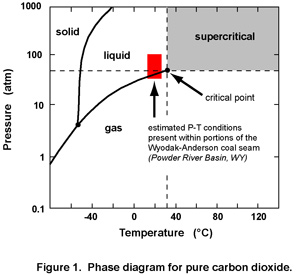
|
Project Title: Geochemistry of Supercritical Carbon Dioxide: Environmental and Energy Resource Application Mendenhall Fellow: Jon Kolak, (703) 648-6750, jkolak@usgs.gov Duty Station: Reston, Virginia Start Date: December 16, 2001 Education: Ph.D. (Geological Sciences), Michigan State University, 2000 Research Advisor: Robert C. Burruss, (703) 648-6144, burruss@usgs.gov |

|
Project Description: Anthropogenic activities have released large amounts of carbon dioxide, a greenhouse gas, into the atmosphere through the combustion of fossil fuels. Concerns regarding global warming and climate change resulting from such release have prompted numerous studies aimed at reducing emissions of carbon dioxide by some mechanism of sequestration. Several potential reservoirs have been proposed for the long-term storage of carbon dioxide, each with its own set of complications. One option for example, is deep-ocean disposal of carbon dioxide (sequestered as hydrate), but slope instability could result in the catastrophic release of greenhouse gases. Biologic disposal by iron fertilization of oceans is another possibility, however, the effect of oceanic biomass stimulation on global carbon dioxide levels and the health of oceanic ecosystems is not well understood and will require much more extensive characterization. Overall reduction of carbon dioxide emissions will likely involve some combination of techniques, but for the immediate future, sequestration of carbon dioxide in geological reservoirs (that is, deep aquifers, oil reservoirs, and coal beds) seems especially promising, as existing knowledge derived from the oil and gas production industries has already helped to solve some of the technological obstacles. Carbon dioxide sequestration in hydrocarbon reservoirs (that is, depleted oil reservoirs and unmineable coalbeds) has an advantage over disposal in deep aquifers by providing additional recovery of hydrocarbons (for example, "recharging" oil reservoirs and enhancing recovery of coalbed methane). The economic return provided by hydrocarbon recovery could defray some of the expense associated with carbon dioxide sequestration.
 Although technologically feasible and economically more desirable, carbon dioxide sequestration in hydrocarbon reservoirs is not without potentially serious environmental consequences. At in situ P-T conditions, the injected carbon dioxide could be near or beyond its critical point (that is, supercritical) (fig. 1). Under these conditions, carbon dioxide is a highly effective solvent, capable of extracting contaminants from geologic materials. Thus, an unintended result of carbon dioxide sequestration in hydrocarbon reservoirs is that toxic compounds, such as polycyclic aromatic hydrocarbons (PAHs), could be mobilized and possibly compromise water quality in nearby aquifers.
Although technologically feasible and economically more desirable, carbon dioxide sequestration in hydrocarbon reservoirs is not without potentially serious environmental consequences. At in situ P-T conditions, the injected carbon dioxide could be near or beyond its critical point (that is, supercritical) (fig. 1). Under these conditions, carbon dioxide is a highly effective solvent, capable of extracting contaminants from geologic materials. Thus, an unintended result of carbon dioxide sequestration in hydrocarbon reservoirs is that toxic compounds, such as polycyclic aromatic hydrocarbons (PAHs), could be mobilized and possibly compromise water quality in nearby aquifers.
The goals of this research project are therefore to delineate the effectiveness with which supercritical carbon dioxide extracts hydrocarbons from geologic materials and determine factors controlling PAH solubility/mobility in sedimentary basins. This research will focus on the association of hydrocarbons within coals, and the potential for the mobilization of PAHs from the coal matrix. Information gained from this study could then be used to determine the most appropriate hydrocarbon reservoirs for storage so as to minimize degradation of environmental quality.
|
|
Previous Profile | Project Profiles | Next Profile |
|
<URL:http://geology.usgs.gov/postdoc/profiles/kolak.html>
Maintained by: Eastern Publications Group Web Team
Last updated 11-December-2002 (krw)